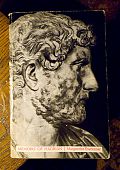
Marguerite Yourcenar
Memoirs of Hadrian x 2
My second reading of Marguerite Yourcenar’s Memoirs of Hadrian was no less powerful than my first, perhaps more powerful. The exquisiteness of Yourcenar’s prose is like a glass of aged fine wine, one wants to take in its taste and smell and color in increments, or to experience the delicious whole all at once. It’s tempting to lie down in long paragraphs, afloat on a current of wonderfully arranged words and ideas.
The difficulty of separating fiction and history that concerned me on my first reading, seem now but a minor issue of a fine line. Yourcenar has thoroughly imbibed the ancient personage of Hadrian, through texts, images and places; her character is more than just a character for he once was a man of flesh and blood whose face can still be seen in stone. Yourcenar wrote Hadrian perhaps better or maybe worse than he actually was, regardless, his portrait is incredibly lifelike, incredibly human.
As I read I found myself associating Hadrian with that ideal in all of us, with everyone who has thought at one time about Humanitas, Libertas, Felicitas, with everyone who has dreamed their own potential and then struggled to reach it. This is the most human of dreams and the most human of hopes.
The only difference between Hadrian and your average dreamer was his position of power: divine ruler, emperor of Imperial Rome from 117 to 138. Somehow Hadrian remained immune to the heady influences of power; he used his high position to travel, to build temples and commission statues, to enjoy life and most importantly, to secure peace for the majority of his reign. Directly after his succession he reversed the conquest of Trajan’s last battles with the Sumerians, wanting only to hold the empire together and gain no more.
When useless servitude has been alleviated as far as possible, and unnecessary misfortune avoided, there will still remain as a test of man’s fortitude that long series of veritable ills, death, old age and incurable sickness, love unrequited and friendship rejected or betrayed, the mediocrity of a life less vast than our projects and duller than our dreams; in short, all the woes caused by the divine nature of things.
It is these “tests of man’s fortitude” that Yourcenar’s Hadrian confronts: a man hanging on the edge of life, near death, confronting the past with all the sureness and steadiness of an objective philosopher. It is perhaps this which lends the book such lucidity.
Hadrian was a Hellenist; an admirer of Greek art and philosophy, he spent much time in Greece. His passion for the young boy Antinous, and his tremendous grief after his suicide, is known to us through the many statues Hadrian had commissioned, from how his favorite’s face and body still fill grand halls. The idealized beauty of the human form, so prominent in Greek sculpture, climaxed in the sadness of a middle-aged man in love with a boy.
Our modern sensibilities find this behavior a little strange, especially in a ruler. Hadrian went so far as to create a cult out of the dead boy, even a city; whatever immortality he had in mind has lasted. But I find this weakness, if it must be called that, this deviancy—though homosexuality was more accepted back then, even pederastic—touching. The statues and images of Antinous are beautiful and Hadrian becomes a greater man to me because of them.
Perhaps my grief itself was only a form of license, a vulgar debauch: I was still the one who profited from the experience and tasted it to the full, for the beloved one was giving me even his death for my indulgence.
In War and Peace, Tolstoy proclaimed that history was best portrayed by the people who lived it and not by the great leaders who stood at its fore. But in Memoirs of Hadrian we have a different history altogether: a different leader, a better one.
· · · · · · · · · · · · · · · · · · · ·